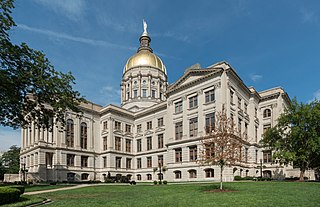
The Georgia State Capitol is an architecturally and historically significant building in Atlanta, Georgia, United States. The building has been named a National Historic Landmark which is listed on the National Register of Historic Places. As the primary office building of Georgia's government, the capitol houses the offices of the governor, lieutenant governor, and secretary of state on the second floor, chambers in which the General Assembly, consisting of the Georgia State Senate and Georgia House of Representatives, meets annually from January to April. The fourth floor houses visitors' galleries overlooking the legislative chambers and a museum located near the rotunda in which a statue of Miss Freedom caps the dome.

A. H. Stephens State Park is a 1,177 acres (476 ha) Georgia state park located in Crawfordville. The park is named for Alexander H. Stephens, the Vice President of the Confederate States of America, and a former Georgia governor. The park contains Stephens' home, Liberty Hall, which has been fully restored to its original 1875 style. The park's museum houses one of Georgia's largest collections of American Civil War artifacts. The park also offers several mill ponds for fishing and nature trails.

Westover Plantation is a historic colonial tidewater plantation located on the north bank of the James River in Charles City County, Virginia. Established in c. 1730–1750, it is the homestead of the Byrd family of Virginia. State Route 5, a scenic byway, runs east–west to the north of the plantation, connecting the independent cities of Richmond and Williamsburg.
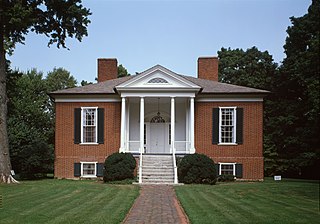
Farmington, an 18-acre (7.3 ha) historic site in Louisville, Kentucky, was once the center of a hemp plantation owned by John and Lucy Speed. The 14-room, Federal-style brick plantation house was possibly based on a design by Thomas Jefferson and has several Jeffersonian architectural features. As many as 64 African Americans were enslaved by the Speed family at Farmington.

Liberty Hall is a historic house museum at 218 Wilkinson Street in Frankfort, Kentucky. Built 1796-1800 by American statesman John Brown, it was designated in 1971 as a U.S. National Historic Landmark for its association with Brown and its fine Federal-style architecture.

Sabine Hall is a historic house located near Warsaw in Richmond County, Virginia. Built about 1730 by noted planter, burgess and patriot Landon Carter (1710–1778), it is one of Virginia's finest Georgian brick manor houses. Numerous descendants served in the Virginia General Assembly. It was added to the National Register of Historic Places in 1969, and declared a National Historic Landmark in 1970. At the time of its National Register listing, it was still owned by Carter / Wellford descendants.

Tulip Hill is a plantation house located about one mile from Galesville in Anne Arundel County in the Province of Maryland. Built between 1755 and 1756, it is a particularly fine example of an early Georgian mansion, and was designated a National Historic Landmark in 1970 for its architecture.
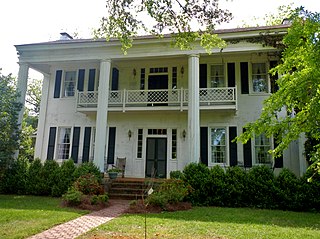
Liberty Hill in La Grange, Georgia, about 0.75 miles (1.21 km) west of the Chattahoochee River in Troup County, is a Greek Revival style plantation house built in the 1830s or 1840s. The original cotton plantation owner, John T. Boykin, bought the piece of land the house is on in 1836. The house with its current 150 acres (61 ha) property, was listed on the National Register of Historic Places in 1975.
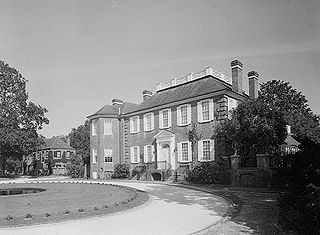
The Fenwick Hall, which is also known as Fenwick Castle, is a plantation house built about 1730 on Johns Island, South Carolina, across the Stono River from James Island and Charleston. It is located between River Road and Penneys Creek. It was named to the National Register of Historic Places on February 23, 1972.

Aspen Hall, also known as the Edward Beeson House, was built beginning in 1771 as a stone house in the Georgian style in what would become Martinsburg, West Virginia. The first portion of the house was a 20 by 20 foot "fortified stone home", 2½ stories tall., in coursed rubble limestone built in 1745 by Edward Beeson I. It is the oldest house in Martinsburg.
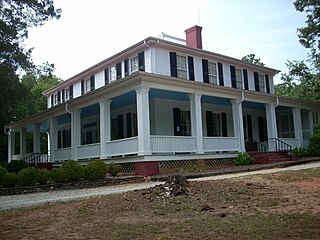
Ashtabula is a plantation house at 2725 Old Greenville Highway near Pendleton in Anderson County, South Carolina, USA. It has been also known as the Gibbes-Broyles-Latta-Pelzer House or some combination of one or more of these names. It was named in the National Register of Historic Places as a historic district on March 23, 1972. It is considered a significant example of a Lowcountry style plantation house built for a Charleston family in the Upstate in the early 19th century. It also is part of the Pendleton Historic District.

Fort Morris Historic Site is a Georgia state historic park in Liberty County, Georgia in the United States. The fort is on a bend in the Medway River and played an important role in the protection of southeast Georgia throughout various conflicts beginning in 1741 and ending in 1865 at the conclusion of the American Civil War, including the French and Indian and American Revolutionary Wars and War of 1812. The historic site is 70 acres (28 ha) and sits at an elevation of 23 feet (7.0 m).
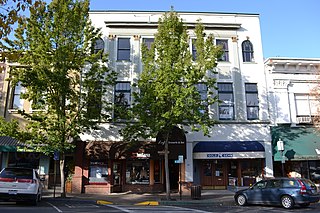
The Ashland Masonic Lodge Building is a historic building located in Ashland, Oregon. Constructed in 1909 as a meeting hall for a local Masonic lodge, it was listed on the National Register of Historic Places in 1992.

Farmer's Delight was built in Loudoun County, Virginia in 1791 by Colonel Joseph Flavius Lane. The Federal style brick plantation house incorporates elements of Georgian architecture. The house is now closely associated with American oilman and diplomat George C. McGhee, who owned the property after 1948. The house is maintained by the McGhee Foundation and is listed on the National Register of Historic Places.

Christian Bechdel II House is a historic home located at Liberty Township, Centre County, Pennsylvania. It was built in 1831, and is a two-story, five bay rectangular brick building measuring 42 feet 8 inches (13.00 m), across and 32 feet 6 inches (9.91 m), deep in the Georgian style architecture. The front facade features a Palladian window in the central bay of the second story. It has a medium pitch, gable roof and a center hall plan interior.

The Bacon-Fraser House is a historic home in Hinesville, Georgia in Liberty County, Georgia, built in 1839, two years after Hinesville was founded. It is a two-story Plantation Plain style house with weatherboard sides. The house is raised and rests on Savannah brick piers. A rear shed room and ell addition was added in 1979, built on foundations that are believed to have been original to rear rooms that were removed in 1923.

The City Hall Park Historic District encompasses one of the central economic, civic, and public spaces of the city of Burlington, Vermont. Centered on City Hall Park, the area's architecture encapsulates the city's development from a frontier town to an urban commercial center. The district was listed on the National Register of Historic Places in 1983.
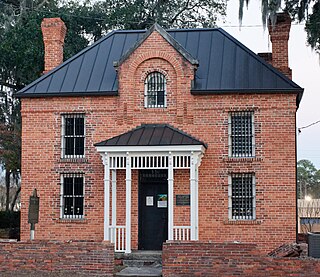
The Liberty County Jail is a historical building in Hinesville, Georgia, built in 1892. It was added to the National Register of Historic Places in 1992.

Snider Hall is a historic building on the campus of Southern Methodist University in University Park, Texas, U.S.. It was built in 1927, and designed by Wyatt C. Hedrick in the Georgian Revival architectural style. It has been listed on the National Register of Historic Places since September 27, 1980.

The Jarrett-Hayes House, also known as Liberty Lodge, in Stephens County, Georgia near Toccoa, is an I-house built around 1848. It was listed on the National Register of Historic Places in 1994.





















